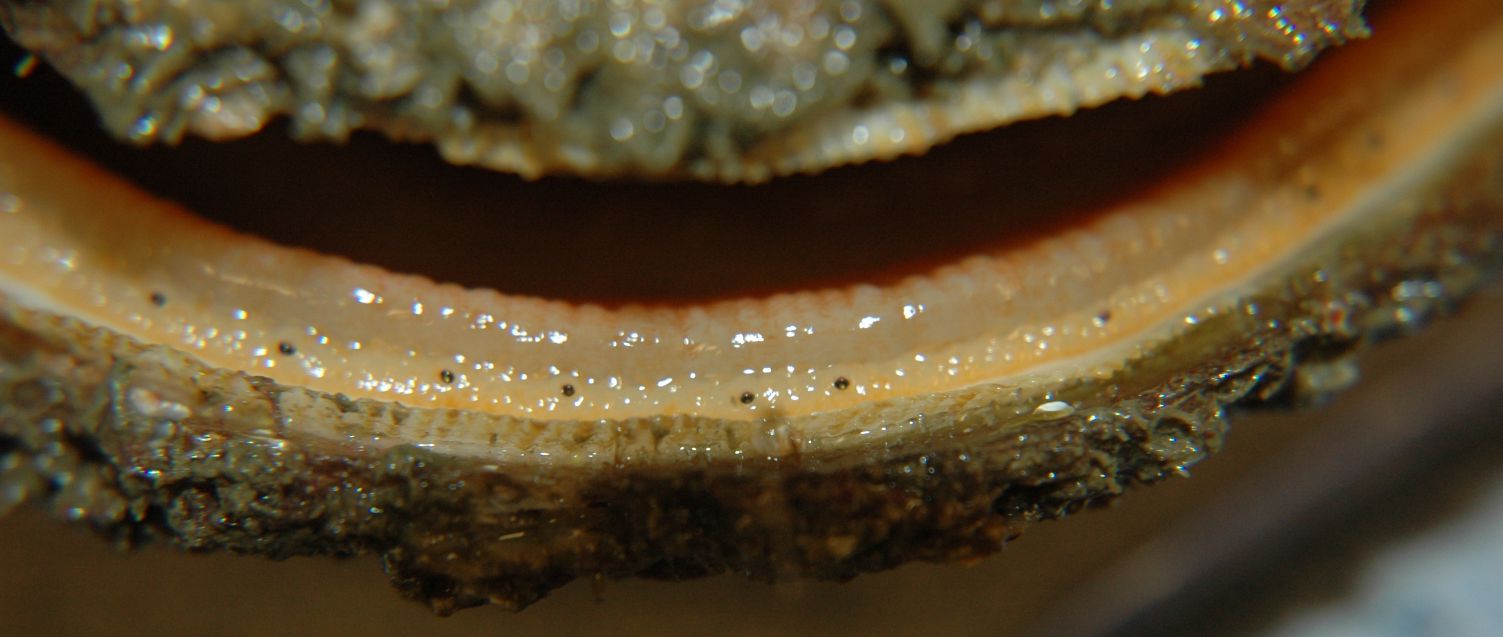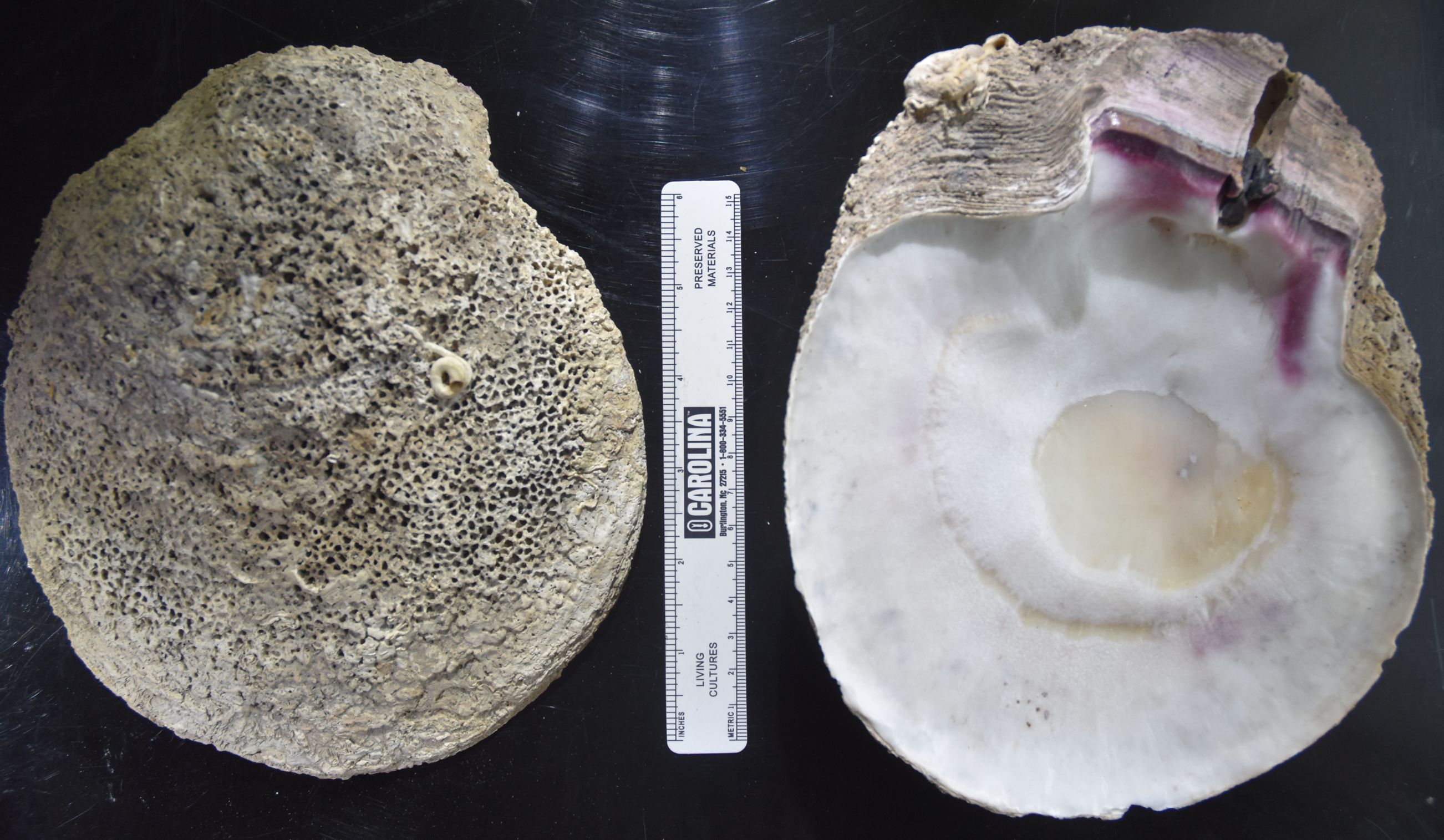Crassodoma gigantea (Gray, 1825)Common name(s): Giant rock scallop, Rock scallop, Purple-hinged rock scallop |
|
| Synonyms: Hinnites giganteus, Hinnites multirugosus, Chlamys gigantea |  |
| Phylum Mollusca
Class Bivalvia Subclass Pteriomorphia Order Ostreoida Suborder Pectinina Family Pectinidae |
|
| Crassodoma gigantea from near Northwest Island in Rosario Bay. Length 12 cm | |
| (Photo by: Dave Cowles, July 2005) | |
How to Distinguish from Similar Species: Oysters such as Crassostrea gigas may be cemented to rocks but do not have the "wing" extensions near the hinge, nor the radial ridges. Other scallop species such as Chlamys hastata are not permanently cemented to the rock. The purple blotch on the inside of the shell near the hinge is distinctive for this species.
Geographical Range: Prince William Sound, AK to Punta Abreojos, Baja California, Mexico
Depth Range: Low intertidal to 78 m
Habitat: On rocky substrates in areas of strong current and the exposed outer coast
Biology/Natural
History: This species
sometimes claps its valve shut with a loud "snap", plainly audible in
the
intertidal zone. Juveniles (up to nearly 5 cm) are not yet
attached.
It takes them about 6 months to grow to this size. Predators
include
the seastar Pisaster
ochraceous and humans. The shells are
often infested with
boring sponges such as Cliona celata (photo)
and with tubedwelling polychaetes, bryozoans, or coralline
algae.
These scallops were used for food by native Americans, and the shells
were
used as pendants, lip plugs, and nose rings, and in making facial and
mask
paint, totems, and images on canoes. Is sometimes a protandrichermaphrodite
(males when small but later become females). Females are
usually
larger and more abundant than males. The testis is white, and
the
ovary is red. In Puget Sound the species spawns mid-May to
mid-June,
with some spawning in September. The larvae (veligers) are planktonic
for 2 months. May live 50 years, but has been depleted from
some
areas due to human harvesting.
| Return to: | |||
| Main Page | Alphabetic Index | Systematic Index | Glossary |
References:
Dichotomous Keys:Flora and Fairbanks, 1966 (as Hinnites multirugosus)
Kozloff 1987, 1996 (as Hinnites giganteus)
Smith and Carlton, 1975 (as Hinnites giganteus)
General References:
Brusca
and Brusca, 1978
Harbo,
1997
Harbo,
1999
Gotshall,
1994
Johnson
and Snook, 1955
Kozloff,
1993
McConnaughey
and McConnaughey, 1985
Morris,
1966
Morris
et al., 1980
O'Clair
and O'Clair, 1998
Ricketts
et al., 1985
Sept,
1999
Scientific
Articles:
Web sites:
General Notes and Observations: Locations, abundances, unusual behaviors:

The eyes can be seen along the margin of the mantle
when the shell is open

A Crassodoma gigantea attached to a rock.
Photo by Dave
Cowles, July 2006

This old, large individual was collected about 1900 and held for many
years in the museum at Washington State University. It measures 21 cm
in
length. The left valve
is on the left and the right valve,
which is attached to a rock in life, is on the right. Note
the prominent,
single adductor
muscle scar, the well-marked pallial
line, and the bright purple stain at the hinge.
The hinge
ligament is narrow but tough, and the 'wings' on each side of
the hinge
are not prominent. The external shell has been perforated by a boring
sponge
and also has a polychaete worm tube attached..
Authors and Editors of Page:
Dave Cowles (2005): Created original page